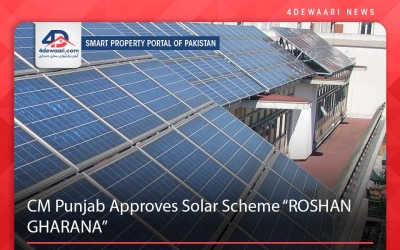Registration of property in Punjab(Pakistan) is a hectic job. Hereunder we'll describe the costs associated with registering a plot of land or a house in Punjab in 2022–2023. Stamp Duty, Registration Fee, TIP (Transfer of Immovable Property Tax), assessed by the District Council, Metropolitan Corporation, or Cantonment Board, Advance Tax under Section 236-K of the Income Tax Ordinance, Advance Tax under Section 236C of the Income Tax Ordinance (often referred to as gain tax), and additional fees if the Map is not approved are some of the taxes, charges, and fees that must be paid by the seller and the buyer for the transfer of immovable property. The following factors affect the costs shown on a property's registry (Sale Deed).
- Is the property a house or an open plot?
- What is a house's covered area?
- Is the property located in an urban or rural area?
- Does the property fall within the jurisdiction of the Cantonment Board, the Metropolitan Corporation, or the District Council?
- Does the purchaser file taxes or not? Does this mean his name is shown as an Active Taxpayer or not in the FBR record?
- Does the seller file taxes or not? Does this mean his name is shown as an Active Taxpayer or not in the FBR record?
- How much is the property worth overall?
- Whether or not the property map has been approved.
- other additional elements could affect the costs associated with land registration, registry, etc.
Let's examine various expenses involved in the registry of property in Punjab.
Registration Fee of Registry
The cost of the property being sold affects the registration charge as well. If the property's value is less than Rs. 5,00,000, only Rs. 500 must be paid as the registration fee. However, a registration fee of Rs. 1,000 must be paid if the property's price exceeds Rs. 5,00,000.
Read Also
Cases of Revised Layout Plans of Housing Schemes to be Reviewed by the CDA Board
Stamp Duty Payable on the transfer of Property
Whether the property is in an urban or rural area may affect the stamp duty percentage. In November 2022, the stamp duty rate for properties located in urban areas will be 1% (it was 2% earlier in 2022, but it is now dropped to 1%), while the rate for properties located in rural areas, among other situations, will be 3% of the property's total value.
TIP Tax on Transfer of Immovable Property
The TIP Tax on a property transfer is determined by several factors, including the property's location—rural versus urban—and whether it is governed by a District Council (Zilla Council), a Metropolitan Corporation, or a Cantonment Board. If a property is located in a rural area or is located within the boundaries of a metropolitan corporation, a TIP tax of 1% of the total price or value of the property must be paid; however, if the property is located within the boundaries of a cantonment board, a TIP tax of 3% of the total purchase price must be paid.
Read Also
Allottees of Lifestyle Residency Asked to Clear Outstanding Dues
Advance Tax payable by the purchaser under Income Tax Ordinance 2001
The buyer of the property is responsible for paying the advance tax under section 236K of the Income Tax Ordinance. T the Federal Board of Revenue (FBR) collects the advance tax. To calculate the advance tax payment required by section 236K of the Income Tax Ordinance, two criteria are currently considered. In contrast, if the buyer is not listed on the Active Tax Payer List (ATL), he is responsible for paying 7% of the price or value of the property. If the buyer is listed on the Active Tax Payer List (ATL), he is responsible for paying 2% of the price or value of the property.
Before the Income Tax Ordinance's change, advance tax under Section 236K was at 1% for filers and 2% for non-filers, as is emphasized above.
Advance Tax/ Gain Tax on Seller under Income Tax Ordinance 2001
The property seller is responsible for paying the advance tax under section 236C of the Income Tax Ordinance. This tax is frequently referred to as the Gain Tax. This tax is also known as withholding tax on occasion. Two considerations must be taken into consideration when calculating tax under section 236C. Sellers are responsible for paying 2% of the gross price or value of the property if they are listed as active taxpayers (ATL) or are filers; however, if they are not, they are responsible for paying 4% of the gross price or value of the property.
Read Also
New Peshawar Valley Housing Project Reviewed by the CM
It is noted that earlier, there were restrictions for the holding period of the property, so Advance Tax under section 236C of the Income Tax Law did not apply to every registry or transaction. For instance, under section 236C, the seller was required to pay advance tax if the property was being sold within four years of the time it was first purchased. However, under section 236C, the seller was not required to pay advance tax if the holding duration of the property was greater than 04 years, such as 5 years or 6 years. At present, the condition of the holding period has been removed and the seller of the property is liable to pay advance tax regardless of the holding period of the property.
Extra Charges When Map of property is not approved
If the property map is not accepted by the appropriate authorities when the property is registered, an additional 2% fee will be applied. This will be a part of the online Challan Form 32-A that you will fill out to pay the stamp duty.
Various Unseen expenses on the registry of property
Further costs related to the Deed Writing of a Registry by a lawyer, Waseeqa Navees, or any other professional, verification and photos of the seller, purchaser, and witnesses, photocopies of pertinent papers, etc. must also be paid in addition to paying government dues and taxes. Paying a sum of money to the officials engaged in transferring property at various levels is another custom in the country.















